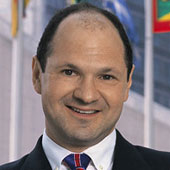New York City’s Limits to Growth
Has the Big Apple and its growth capacity finally peaked?
February 8, 2001
Prosperity is sometimes not all it’s cracked up to be — especially when you find yourself stuck in traffic in midtown Manhattan. As you desperately seek a place to park your car, you realize with a hopeless, sinking feeling that every other driver is also looking for the same elusive parking place.
This kind of urban congestion that New Yorkers commonly face is just one small aspect of a gloomy scenario once predicted by the Club of Rome, a little-known think tank. Published in 1972, the group’s sensational report, “Limits to Growth,” used a series of mathematical models to suggest that the world would deplete its natural resources in less than a hundred years. Its authors sternly advocated immediate, drastic curbs on population growth and economic development.
The report was controversial from the start — even though the very next year the first oil crisis seemed to confirm its main thesis. But in the buoyant 1980s and 1990s, it had become unfashionable to think about the future with anything less than boundless optimism.
Yet, living in Manhattan, you quickly realize that there is an actual physical limit to economic growth and that it is now at hand. On Manhattan’s West Side, for example, there are literally no legal parking spaces to be had at any time of day or night.
Parking garages charge up to $35 per hour — not per day (which would be high enough). One begins to believe that if New York were a city in the Mediterranean, people would regularly be murdered for their parking spots.
Being stuck inside a Manhattan apartment is not any better. In fact, some apartments in the city are smaller than Korean-made sub-compact cars. Then, you call in a real estate agent and discover that your dog house-sized studio apartment is worth an astronomical amount of money. That’s the good news.
The bad news is that for all that money you can only get an even smaller place in the far reaches of Brooklyn. Looking for an apartment in New York City has never been an experience for the claustrophobic. Nowadays, even the most phobia-free person should avoid looking at the real estate sections of New York’s newspapers.
It seems that there isn’t room for one more car, one more commuter, one more apartment building. An island measuring just 23 square miles, Manhattan already has 1.5 million residents.
After losing population for decades, it started to attract newcomers in the mid-1980s. It gained 70,000 people — or around 5% of its population — just between 1993 and 1996. In the final years of the 1990s, migration to New York has increased further as its economy boomed.
Less than 20% of New York State residents were actually born in the state, ranking it 48th out of 50 states in that regard. New York City has an even larger proportion of out-of-towners, who bring four million cars into New York City on a daily basis.
While the city has been getting more and more prosperous, a strange, wholly un-American process has been underway. The middle class, the backbone of the American Dream, has started to disappear. This is somewhat strange, considering that city officials had bragged that the middle class were beginning to return to the city after the financial crisis of the mid-1970s.
In fact, the number of middle class households actually increased by 100,000 between 1977 and 1989. But by 1996, after several years of economic prosperity, the number of middle class households had again shrunk by 115,000.
It is tempting to think that there has been a polarization in incomes. But the process has been rather lopsided. The city has been overrun by the rich. Indeed, who else could afford New York City prices?
Housing costs 4.5 times more than the average around the country. New Yorkers pay 87% more for health care — and half again as much for groceries.
The composite cost-of-living index in New York City is more than twice the national average. In short, even if you’re rich by the standards of the rest of the United States, New York City offers you an opportunity to experience what it means to be poor.
But just like the Club of Rome, we could easily jump to the wrong conclusions. There were periods in New York history when it seemed impossible that the city could grow any larger. The city built it subway system a hundred years ago in order to relieve the near-permanent gridlock in the streets above ground. In the early 20th century, the city found another dimension in which it could expand — skyward. Perhaps in the 21st century, it can move into cyberspace.
Or perhaps it will resolve its problems the old-fashioned way — with the help of a financial crisis, which will drive all the newcomers out of the city. In fact, recent reports suggest that congestion in New York City has finally moderated since the advent of the economic slowdown. If this turns out to be the case, then even Wall Streeters upset by New York’s seemingly indomitable traffic jams may start praying for a recession.
Read previous
Kofi Annan on Global Futures
February 6, 2001
